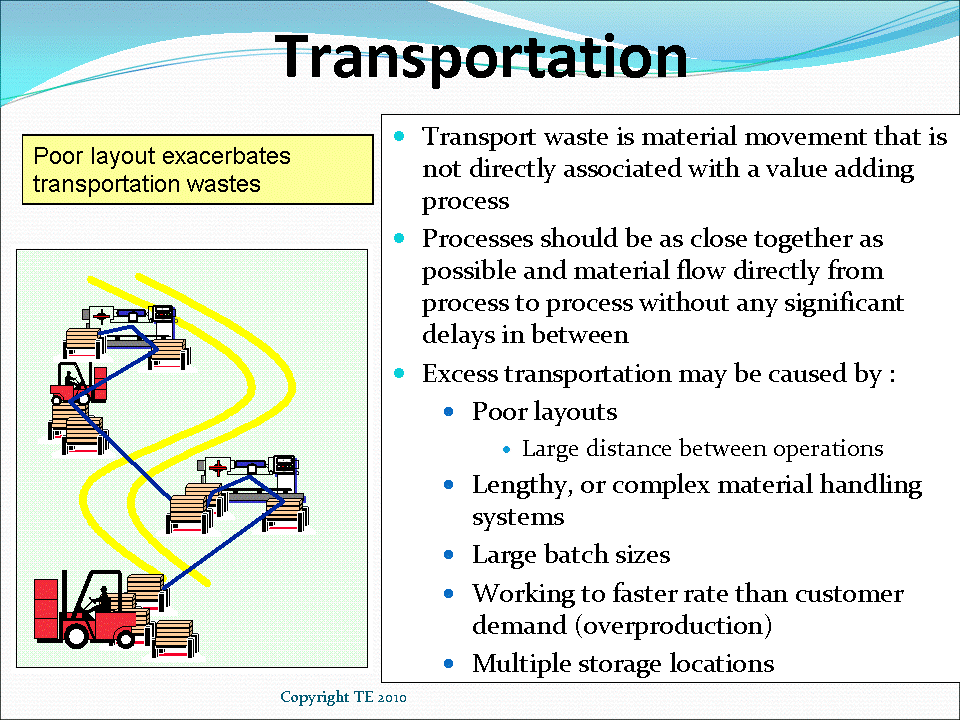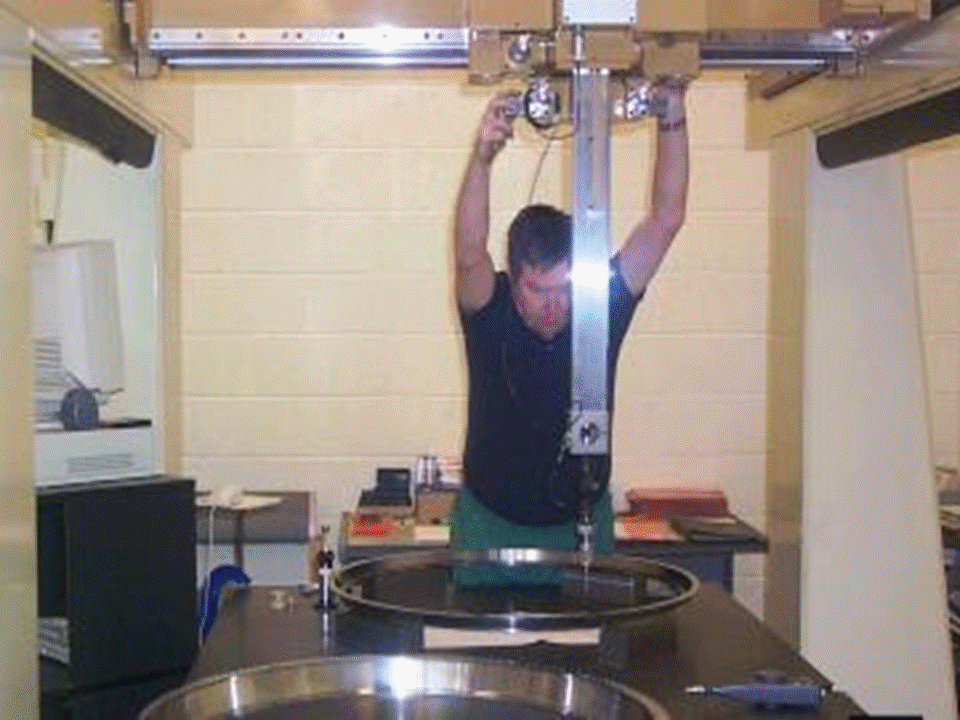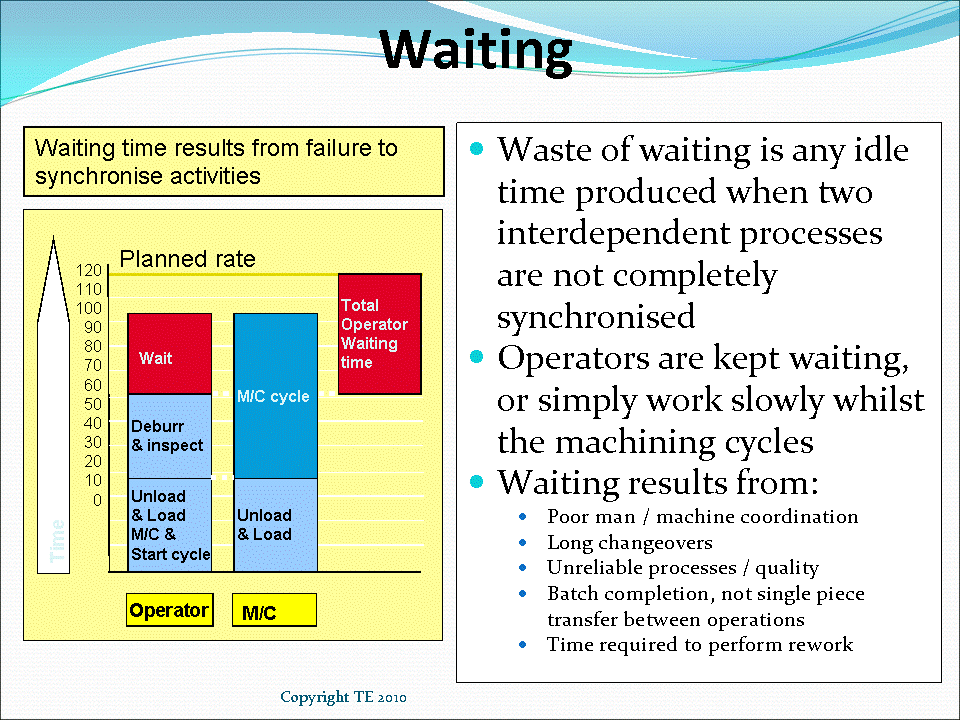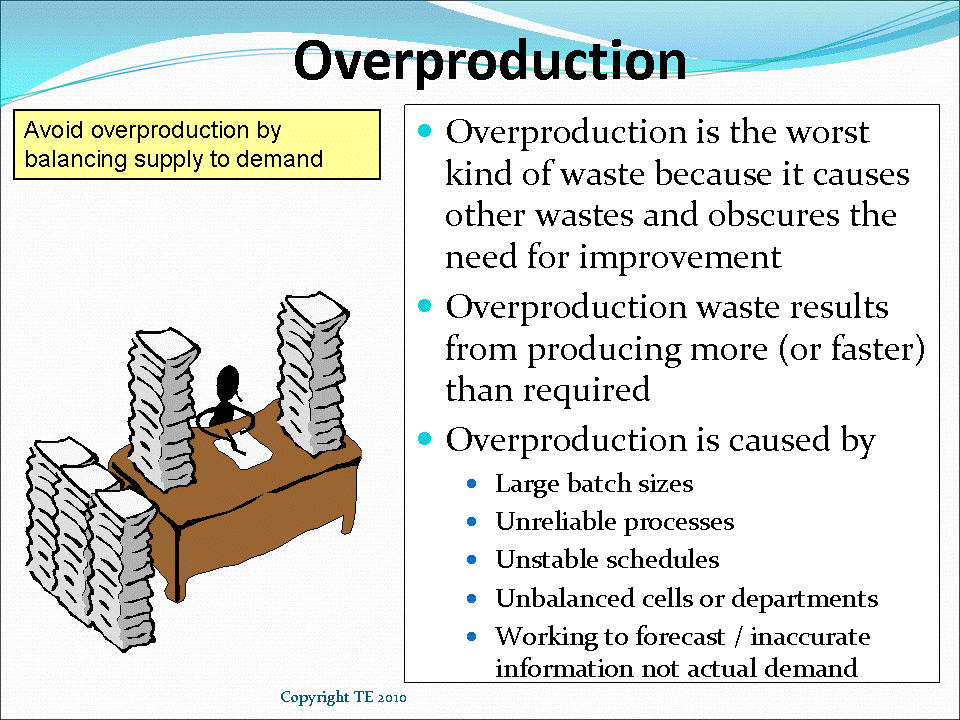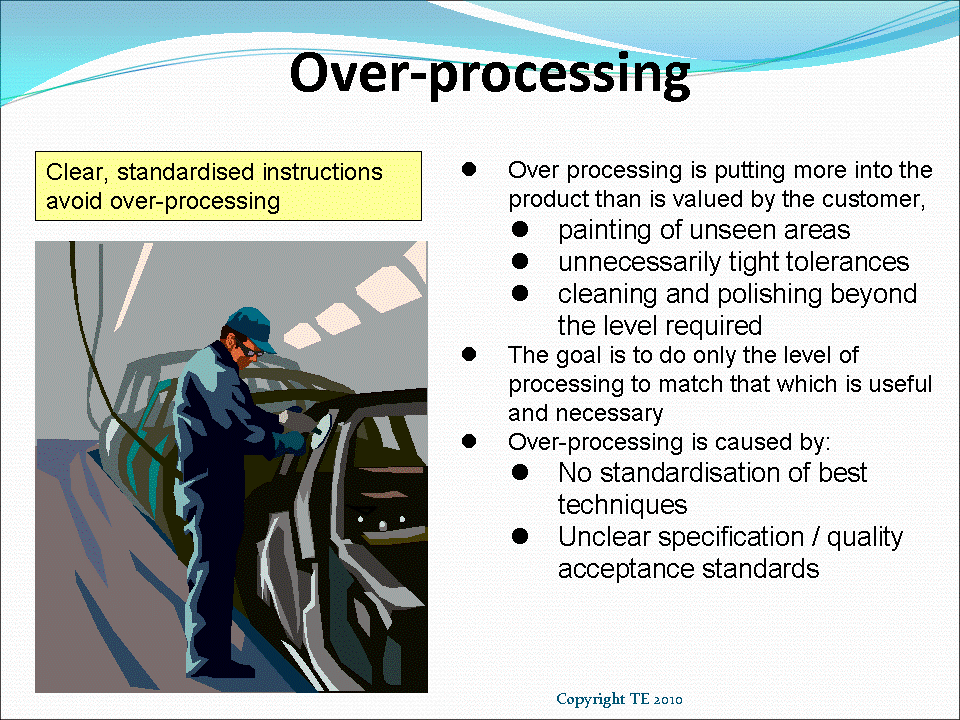The seven wastes of Lean Manufacturing are what we are aiming to remove from our processes by removing the causes of Mura and Muri as well as tackling Muda directly. But what exactly are the seven wastes of Lean Manufacturing.
- Inventory
- Motion
- Waiting
- Over-Processing
- Overproduction
- Defects
What Exactly is Waste?
The simplest way to describe waste is as “Something that adds no Value.” Our customers would not be happy to pay for any action that we take that does not add value to what they actually want and nor should we be.
Would you want to pay for the machine operators wages whilst they sat idle waiting for a delivery, or for the rework processes that had to be undertaken because the machine was incorrectly set, or even for storing your product for three months before it was delivered to the store? These wastes are included within the cost of your products, either inflating the price you pay or reducing the profit of the company.
Why Remove Waste?
Your companies Profit is your selling price less your costs, no matter how you think about the selling price it is very much dictated by the market not by yourself. If you charge too much then your customers will go elsewhere, even if you charge too little you may lose customers as they will perceive there may be something wrong with what you are offering. Therefore the only way you have to improve your profits are to reduce your costs; this means removing all elements of waste from your processes.
In addition to improving your profits you will find that waste has a major impact on your customer’s satisfaction with your products and services. Your customers want on time delivery, perfect quality and at the right price. Something that you cannot achieve if you allow the 7 wastes to persist within your processes.
The Waste of Transport
Transport is the movement of materials from one location to another, this is a waste as it adds zero value to the product. Why would your customer (or you for that matter) want to pay for an operation that adds no value?
Transport adds no value to the product, you as a business are paying people to move material from one location to another, a process that only costs you money and makes nothing for you. The waste of Transport can be a very high cost to your business, you need people to operate it and equipment such as trucks or fork trucks to undertake this expensive movement of materials.
Transport adds no value to the product, you as a business are paying people to move material from one location to another, a process that only costs you money and makes nothing for you. The waste of Transport can be a very high cost to your business, you need people to operate it and equipment such as trucks or fork trucks to undertake this expensive movement of materials.
The Waste of Inventory
Inventory costs you money, every piece of product tied up in raw material, work in progress or finished goods has a cost and until it is actually sold that cost is yours. In addition to the pure cost of your inventory it adds many other costs; inventory feeds many other wastes.
Inventory has to be stored, it needs space, it needs packaging and it has to be transported around. It has the chance of being damaged during transport and becoming obsolete. The waste of Inventory hides many of the other wastes in your systems.
Inventory has to be stored, it needs space, it needs packaging and it has to be transported around. It has the chance of being damaged during transport and becoming obsolete. The waste of Inventory hides many of the other wastes in your systems.
The Waste of Motion
Unnecessary motions are those movements of man or machine which are not as small or as easy to achieve as possible, by this I mean bending down to retrieve heavy objects at floor level when they could be fed at waist level to reduce stress and time to retrieve. Excessive travel between work stations, excessive machine movements from start point to work start point are all examples of the waste of Motion.
All of these wasteful motions cost you time (money) and cause stress on your employees and machines, after all even robots wear out.
All of these wasteful motions cost you time (money) and cause stress on your employees and machines, after all even robots wear out.
The Waste of Waiting
How often do you spend time waiting for an answer from another department in your organization, or waiting for a delivery from a supplier or an engineer to come and fix a machine? We tend to spend an enormous amount of time waiting for things in our working lives (and personal lives too), this is an obvious waste.
The Waste of Waiting disrupts flow, one of the main principles of Lean Manufacturing, as such it is one of the more serious of the seven wastes or 7 mudas of lean manufacturing.
The Waste of Waiting disrupts flow, one of the main principles of Lean Manufacturing, as such it is one of the more serious of the seven wastes or 7 mudas of lean manufacturing.
The waste of Overproduction
The most serious of all of the seven wastes; the waste of overproduction is making too much or too early. This is usually because of working with oversize batches, long lead times, poor supplier relations and a host of other reasons. Overproduction leads to high levels of inventory which mask many of the problems within your organization.
The aim should be to make only what is required when it is required by the customer, the philosophy of Just in Time (JIT), however many companies work on the principle of Just in Case!
The aim should be to make only what is required when it is required by the customer, the philosophy of Just in Time (JIT), however many companies work on the principle of Just in Case!
The Waste of Over-processing
The waste of Overprocessing is where we use inappropriate techniques, oversize equipment, working to tolerances that are too tight, perform processes that are not required by the customer and so forth. All of these things cost us time and money.
One of the biggest examples of over-processing in most companies is that of the “mega machine” that can do an operation faster than any other, but every process flow has to be routed through it causing scheduling complications, delays and so forth. In lean; small is beautiful, use small appropriate machines where they are needed in the flow, not break the flow to route through a highly expensive monstrosity that the accountants insist is kept busy!
One of the biggest examples of over-processing in most companies is that of the “mega machine” that can do an operation faster than any other, but every process flow has to be routed through it causing scheduling complications, delays and so forth. In lean; small is beautiful, use small appropriate machines where they are needed in the flow, not break the flow to route through a highly expensive monstrosity that the accountants insist is kept busy!
The Waste of Defects
The most obvious of the seven wastes, although not always the easiest to detect before they reach your customers. Quality errors that cause defects invariably cost you far more than you expect. Every defective item requires rework or replacement, it wastes resources and materials, it creates paperwork, it can lead to lost customers.
The Waste of Defects should be prevented where possible, better to prevent than to try to detect them, implementation of pokayoke systems and autonomation can help to prevent defects from occurring.
The Waste of Defects should be prevented where possible, better to prevent than to try to detect them, implementation of pokayoke systems and autonomation can help to prevent defects from occurring.
Lean Manufacturing Process
The process has three key stages:
Stage 1 – Identify Waste
According to the Lean philosophy, waste always exists, and no matter how good your process is right now, it can always be better. This commitment to continuous improvement is known as Kaizen .One of the key tools used to find this waste is a Value Stream Map (VSM). This shows how materials and processes flow through your organization to bring your product or service to the consumer. It looks at how actions and departments are connected, and it highlights the waste. As you analyze the VSM, you'll see the processes that add value and those that don't. You can then create a "future state" VSM that includes as few non-value-adding activities as possible.
Stage 2 – Analyze the Waste, and Find the Root Cause.For each waste you identified in the first stage, figure out what's causing it by using Root Cause Analysis . If a machine is constantly breaking down, you might think the problem is mechanical and decide to purchase a new machine. But Root Cause Analysis could show that the real problem is poorly trained operators who don't use the machine properly. Other effective tools for finding a root cause include Brainstorming and Cause and Effect Diagrams .
Stage 3 – Solve the Root Cause, and Repeat the CycleUsing an appropriate problem-solving process, decide what you must do to fix the issue to create more efficiency.
Tools to Reduce Waste
Once you have identified wastes using the three key stages above, you can then apply this next set of tools to help you reduce waste further:
Just in Time – This is the core idea of Lean and is based on the "pull" model. To minimize stock and resources, you only purchase materials, and produce and distribute products when required. You also produce small, continuous batches of products to help production run smoothly and efficiently. By reducing batch size, you can also monitor quality and correct any defects as you go. This reduces the likelihood of quality being poor in future batches.
Kanban – This is one of the key ways to involve people in the Lean process. Here, you support the Just In Time model by developing cues in the system to signal that you need to replace, order, or locate something. The focus is on reducing overproduction, so that you have what you need, only when you need it.
Zero Defects – This system focuses on getting the product right the first time, rather than spending extra time and money fixing poor-quality products. By using the Zero Defects system, you'll reinforce the notion that no defect is acceptable, and encourage people to do things right the first time that they do something.
Single Minute Exchange of Die (SMED) – This helps you build flexibility into your production. For example, in the automotive industry, it could take days to change a line to produce a different car model. With SMED, the assembly process and machinery are designed to support quick and efficient changeovers.
The 5S Philosophy – Lean depends on standardization. You want your tools, processes, and workplace arrangements to be as simple and as standard as possible. This creates fewer places for things to go wrong, and reduces the inventory of replacement parts that you need to hold. To accomplish a good level of standardization, use the 5S System .
Key Points
Lean Manufacturing focuses on optimizing your processes and eliminating waste. This helps you cut costs and deliver what the customer wants and is willing to pay for.
With a lean philosophy, you enjoy the benefit of continuous improvement. So, rather than making rapid, irregular changes that are disruptive to the workplace, you make small and sustainable changes that the people who actually work with the processes, equipment, and materials will take forward.
This systematic and simple approach is very effective across all types of industries. What's more, ultimately, a process without waste is much more sustainable.
References
http://leanmanufacturingtools.org/
http://www.mindtools.com/
References
http://leanmanufacturingtools.org/
http://www.mindtools.com/

